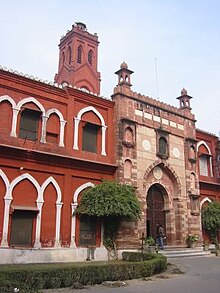Aligarh movement
The Aligarh Movement ( English Aligarh Movement ) is a political movement that originated from the Muslim elite of the Indian subcontinent and aims at the emancipation of the Muslim masses through modern education. It originated in the 19th century, especially with the establishment of Mohammedan Oriental College English ( Muhammedan Anglo-Oriental College , in short: MAO College ) in 1875, the later Muslim University Aligarh ( Aligarh Muslim University ).

The movement takes its name from the college in the city of Aligarh (approx. 100 km southeast of the Indian capital New Delhi ) in the United Provinces of Agra and Avadh ( United Provinces of Agra and Oudh ), where it originated.
The reformer Syed Ahmad Khan (1817–1898), the founder of the Muslim Anglo-Oriental College, was a major influence on the Muslim party of the All India Muslim League , he was one of the main figures of the movement as well as the Urdu movement ( Urdu movement ). The Aligarh movement is thus a forerunner of the Pakistan movement ( Tehrik-i Pakistan ), which aimed to establish a state for Muslims in India in the 1940s. Maulana Hali (1837–1914), Syed Ameer Ali (1849–1928), Shibli Numani (1857–1914), Ziauddin Ahmad (1878–1947) and Zakir Husain (1897–1969) were important figures in the Aligarh movement.
The British orientalist Thomas Walker Arnold (1864–1930), a friend of Syed Ahmad Khan, taught at MAO College .
See also
literature
- Ashraf Faruqi: European involvement in the Aligarh movement: the role and influence of the European faculty in the social and political aspects of the Mohamedan Anglo-Oriental College, 1875–1920, Ph.D. thesis, Duke University, 1978
- Tariq Hasan: The Aligarh Movement and the Making of the Indian Muslim Mind, 1857–2002 . 2006 ( book trade link )
- Shan Muhammad (Ed.): The Aligarh Movement - Basic Documents. Meenakshi Prakashan, Meerut. 1978 ( partially digitized ; library link )
- Jamal Malik: Islamic scholarly culture in northern India . 1997 ( partial online view )
- Barbara Daly Metcalf: Islamic Revival in British India. Deoband, 1860-1900. Princeton 1982
- Margrit Pernau : Citizen with a turban. Muslims in Delhi in the 19th century. 2008 ( partial online view )
- Urdu literature. 1991. House of World Cultures ( partial online view )
- Werner Ende, Udo Steinbach, Renate Laut (eds.): Islam in the present. 2005 ( partial online view )
- Surjit Mansingh: Historical Dictionary of India. 2nd ed., 2006 ("Aligarh Movement", pp. 49–51 partial online view )
Web links
- Aligarh Movement
- Sir Syed Ahmed Khan and the Aligarh Movement
- Where reform-oriented Islam was at home
- Sir Syed in Hyderabad
References and footnotes
- ^ The All-Indian Muhammadan Anglo-Oriental College, or MAO College for short, was initially a boys' school and college to train committed Muslims according to Western curricula. In 1920 it became a university, and in 1938 women were admitted to some faculties. (see Historical Dictionary of Islam . Second Edition. Ludwig W. Adamec Historical Dictionaries of Religions, Philosophies, and Movements , No. 95) The Scarecrow Press, Inc. Lanham, Maryland • Toronto • Plymouth, UK 2009 ( digitized version )
- ↑ cf. IRIB: "The members of the Muslim League were mainly people close to the Aligarh movement, which was founded in collaboration with capital owners and large landowners. The Muslim League played an important role in the partition of India and the establishment of Pakistan on May 14th. Played August 1947. " Islamic Culture and Civilization through History (96) ( Broadcast manuscript of the Islamic Republic of Iran Radio , September 1, 2014)
- ↑ The website aligarhmovement.com offers an extensive list of various officials and dignitaries of the movement .
- ↑ The author of The preaching of Islam: a history of the propagation of the Muslim faith. Westminster 1896, A. Constable & Co. (see Sir Thomas Walker Arnold Aligarh Movement digitized version )